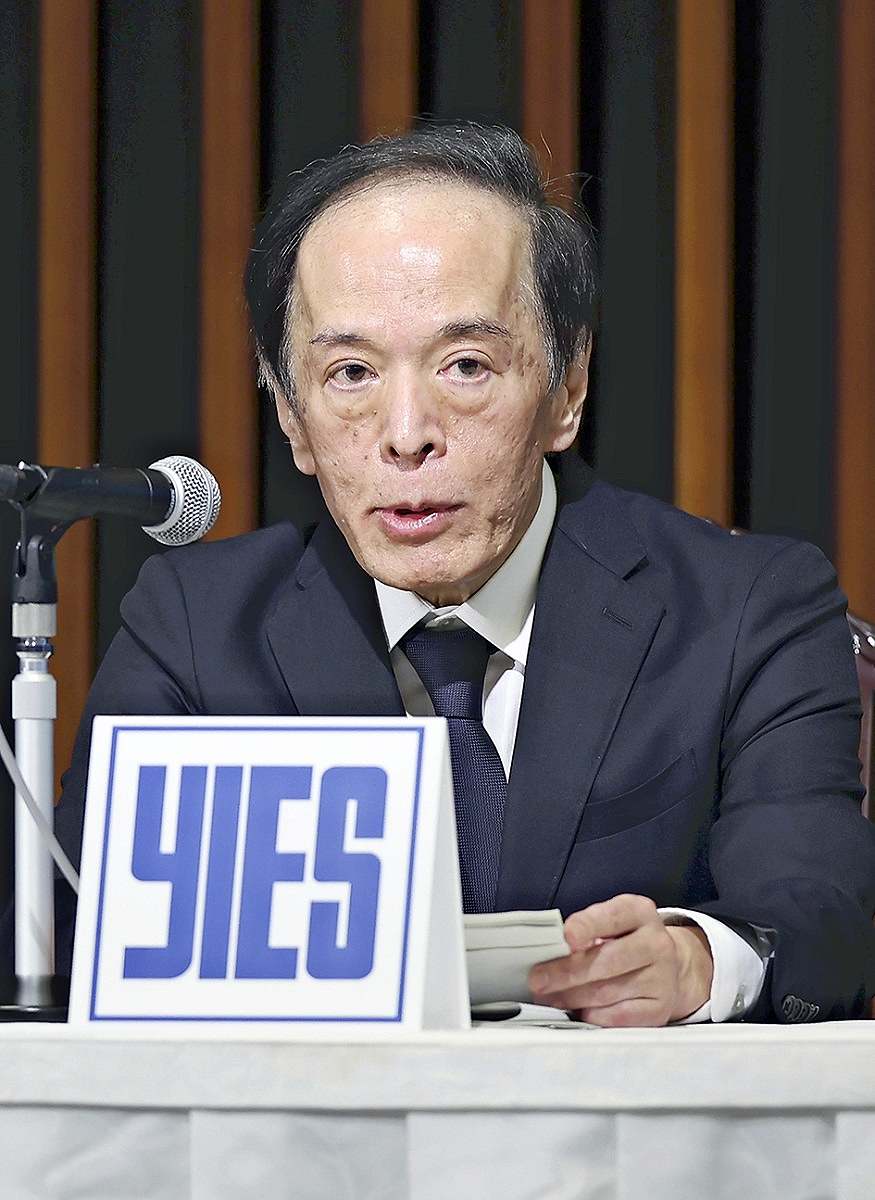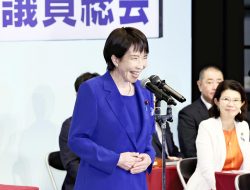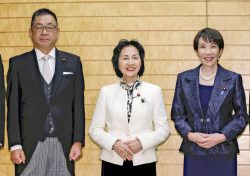Currency Exchange Rates Challenge the Bank of Japan; Moves by Fed Further Complicate Japan’s Situation

Bank Of Japan Gov. Kazuo Ueda speaks at Yomiuri International Economic Society (YIES) symposium in Tokyo on May 8.
8:00 JST, May 25, 2024
In March of this year, the Bank of Japan under Gov. Kazuo Ueda ended the longstanding “different-dimension” monetary easing measures implemented by his predecessor Haruhiko Kuroda. Although the BOJ raised interest rates for the first time in 17 years, the trend of yen depreciation and dollar appreciation continued, and criticism of the BOJ began to mount. Before the coronavirus pandemic, the BOJ had been forced to deal with a strong yen, but now its new challenge is strategically dealing with a weak yen.
Many countries recently — not only Japan — have been concerned about the depreciation of their currencies due to the strong dollar.
The U.S. Federal Reserve is struggling to control inflation, and financial markets are increasingly expecting it to maintain a high policy rate, which had led to the dollar’s global appreciation, for a longer time. Emerging economies are increasingly concerned because having weaker currencies will lead to inflation due to higher import prices and increase the burden of repaying dollar-denominated debts.
However, the United States appears unconcerned, believing that a strong dollar is a sign of the strength of the U.S. economy. Under the regime of the dollar as the world’s reserve currency, other countries are often at the mercy of U.S. economic policy.
This harsh reality was bluntly summed up in 1971 by U.S. Treasury Secretary John Connally, speaking to a group of European finance ministers at a Group of 10 meeting in Rome during the administration of U.S. President Richard Nixon, not long after the “Nixon Shock” in which the United States had shaken the dollar reserve currency system by suspending the convertibility of dollars into gold.
Connally said, “The dollar is our currency, but it’s your problem.”
This statement, which shocked other countries and is still quoted today, symbolizes how the United States often puts its own interests first despite its special responsibilities under the dollar reserve currency regime.
For example, at the Group of 20 Seoul Summit on Nov. 11-12, 2010, other countries poured concentrated fire on U.S. President Barack Obama.
On Nov. 3, 2010, the Fed had implemented its second round of quantitative easing (QE2), in which it purchased a massive $600 billion worth of Treasuries, flooding the market with money and propping up the U.S. economy.
At the same time, QE2 caused a global dollar depreciation, significantly impacting emerging economies. Funds flowed into emerging economies, searching for lucrative investment opportunities, causing those countries’ currencies to appreciate and hurting their exports.
The United States was the epicenter of the financial crisis in the fall of 2008, and other countries strongly criticized its selfishness in taking a massive monetary easing step without regard to the impact on other countries.
At a meeting of Asia-Pacific Economic Cooperation (APEC) finance ministers just before the 2010 summit, U.S. Treasury Secretary Timothy Geithner had to assert: “The United States has no intention of using the dollar to enhance our competitiveness. We recognize the role and special responsibility of the dollar.”
But when I covered the G20 Summit as a correspondent, the United States did not appear too concerned about criticism from other countries.
After leaving office, Fed Chairman Ben Bernanke wrote a book called “The Courage to Act” in which he recalled: “A week after our announcement, President Obama heard a torrent of criticism of QE2 while attending a G20 summit in Seoul, South Korea. When I next met with him, two months later, I jokingly apologized for causing him so much trouble. He laughed and said that he wished we could have waited a week.”
In retrospect, Japan may have been one of the countries most affected by QE2.
In fact, on Oct. 31, 2011, about a year after QE2, the yen hit ¥75.32 against the dollar, its strongest level since World War II, plunging the Japanese economy into a difficult situation.
At the time, the Japanese economy was under six kinds of pressure at once:
■ A strong yen
■ High corporate tax rates
■ Strict labor regulations, such as on layoffs
■ Delays in free trade agreements
■ Stringent greenhouse gas reduction targets
■ Electricity shortages in the wake of the Great East Japan Earthquake
Public opinion was particularly critical of the BOJ’s inaction regarding the strong yen.
Monetary policy has a strong influence on exchange rates. As funds move internationally in the direction of favorable investment opportunities, currencies tend to appreciate when central banks raise policy rates and depreciate when they lower them.
However, central banks in major developed countries conduct monetary policy with the objective of price stability. There is a tradition that economic policy should not target exchange rates, as the free market should determine those rates.
The BOJ, under Gov. Masaaki Shirakawa from 2008-13, had sincerely kept to this tradition. Therefore, even though the BOJ did introduce a series of monetary easing measures, they were lackluster and failed to reverse the yen’s appreciation against the dollar.
One BOJ official in recent months recalled, “Without the Fed’s QE2, the BOJ might not have had to implement such a massive easing program under Gov. Kuroda.”
Kuroda, appointed as Shirakawa’s successor by Prime Minister Shinzo Abe in the spring of 2013, introduced different-dimension monetary easing to achieve the 2% price stability target and end deflation as soon as possible.
Although the BOJ did not officially say that its monetary easing measures directly aimed to correct the yen’s appreciation, many economists thought this was a significant objective.
Evaluating the BOJ’s monetary policy from the perspective of exchange rate stability, it can be said that monetary easing had clearly corrected the excessive yen appreciation, and the exchange rate had stabilized at around ¥100-¥120 to the dollar until spring 2022.
The BOJ’s policy objective of achieving price stability of 2% was deeply tied to the realistic aim of curbing the yen’s appreciation.
However, when the economic impact of the coronavirus pandemic flipped the problem from yen appreciation to yen depreciation after the spring of 2022, this strategy made it difficult for the BOJ to respond flexibly.
The large gap between the Fed’s interest rate of 5.25%-5.50% and the BOJ’s policy rate of around 0.0%-0.1% is adding to the downward pressure on the yen.
The persistently high costs of energy, an area in which Japan is heavily reliant on imports, along with substantial digital trade deficits and the trend of companies relocating their factories overseas, have all significantly intensified the yen-weakening pressure.
As the G7’s only Asian member, Japan has occupied a privileged position concerning its economic presence and role in international finance. However, the rise of China and other emerging economies has reduced Japan’s presence from about 18% of global gross domestic product in 1995 to 4% in 2022 on a dollar basis.
It is difficult to predict whether the Japanese economy, concerned about the prolonged appreciation of the yen, will have to enter a new phase of fighting the yen’s depreciation as its national strength declines, or whether the yen’s depreciation will be only temporary.
If the fight against the weak yen drags on, will the BOJ be able to handle it?
Of course, the BOJ will officially say that it is not conducting monetary policy to stop the yen from weakening.
However, the BOJ must manage its monetary policy in the face of growing social criticism of the weak yen. Economists think the most effective way for the BOJ to prevent the yen from weakening would be to raise interest rates quickly. Indeed, it is not uncommon for central banks in emerging and developing countries to raise interest rates to protect their currencies.
However, if the BOJ were to raise policy rates quickly, it could slow the economy, making the 2% price stability target more difficult to achieve. It could also make raising funds more difficult for small and medium-sized enterprises. Higher mortgage rates also cool consumer spending. There are high political hurdles to raising interest rates, as the adverse effects on the public would be easily visible.
The governor of the central bank is like a conductor of the economy. Ueda, who stepped up to the podium just last year, faces a significant and difficult task in ending the unprecedented monetary easing measures and steering monetary policy.
Faced with the problem of a weak yen, Ueda will need to explain the aims of his policies and, at times, send a strategic message of restraint to the overheating financial markets.
Political Pulse appears every Saturday.

Akihiro Okada
Akihiro Okada is an editorial writer for The Yomiuri Shimbun.
"Editorial & Columns" POPULAR ARTICLE
-

Violations of Subcontract Law: Major Automakers Must Eliminate Old Practices
-

Local Governments’ Tax Revenues: Devise Ways to Correct Imbalances in Tax Sources
-

5 Japanese Business Dinner Mistakes to Avoid — and What They Taught Me About Business in Japan
-

Heavy Rains in Asia: Support for Victims, Flood-Control Measures Urgently Needed
-

Rice Coupons: A Misguided Approach to Countering Rising Prices
JN ACCESS RANKING
-

Tokyo Economic Security Forum to Hold Inaugural Meeting Amid Tense Global Environment
-

Keidanren Chairman Yoshinobu Tsutsui Visits Kashiwazaki-Kariwa Nuclear Power Plant; Inspects New Emergency Safety System
-

Imports of Rare Earths from China Facing Delays, May Be Caused by Deterioration of Japan-China Relations
-

University of Tokyo Professor Discusses Japanese Economic Security in Interview Ahead of Forum
-

Japan Pulls out of Vietnam Nuclear Project, Complicating Hanoi’s Power Plans

























